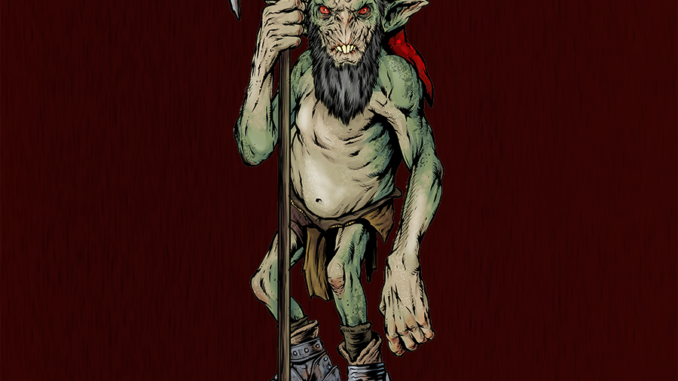
Many tabletop roleplaying games incorporate stock art into their products. Stock art is as bedrock to indie RPGs as dice, OGLs, Creative Commons, and original ideas. To insure you have art for your newest RPG, or to show during your crowdfunding campaign, many websites and publishers offer stock art. I was inspired to write this piece after I bought some art via DriveThruRPG’s limited time sale, “Take Stock! Stock Art Sale”.
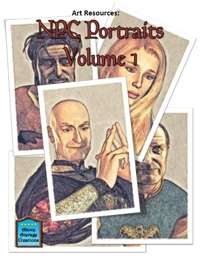
[This article is going to read like I’m shilling so, before I do that, let me show my hand. I participate in OneBookShelf’s Affiliate Program which means if you use a link in this article and buy something on DriveThruRPG I’ll get a commission. That said, I wanted to do this piece to talk about stock art and why it’s a win for tabletop RPGs.]
DriveThruRPG’s sale features stock art at 50% off the regular price. By purchasing these images you obtain a licensed piece of art that you can use to enhance your project without blowing out your budget. How economical can stock art really be? Through this sale, I dropped $2.99 to license 92 fantasy images. While I specifically went cheap, every single image is worth more than I paid for the whole purchase. If I only use one of these images, I’ll have more than justified the entire purchase.
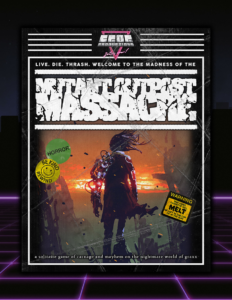 What Is Stock Art?
What Is Stock Art?
Stock art is considered illustrations and photographs that are non-exclusively licensed to the purchaser for use within their personal and commercial productions. As long as the purchaser does not sublet or sell the images as stock art, they’re free to use the images as they choose (with some caveats). That means if you buy the license, you can use the images in your project and, if I buy the license, I can use the same artwork for my project. This may result in the images appearing in multiple places, but the cost savings justify the duplication.
As an example of how stock art works, I’m going to use Tithi Luadthong’s piece. Below is the cover for Crushpop Productions’ Mutant Outpost Massacre. During the Kickstarter for Psionics Guide from Dreamscarred Press, they utilized the same image for their cover. Another Kickstarter, Legacy: Life Among the Ruins 2nd Edition, from UFO Press presented their cover mockup with the same piece (that they ultimately replaced with an original piece by Tithi). During the campaign, Legacy creator Jay Iles shared this comment:
“A good amount of Tithi’s art for Legacy we licensed under a non-exclusive agreement, and it looks like a lot of other people have started licensing their art too. That’s why we changed the cover to a piece of their art we had the full and exclusive rights to!”
As you can see, one image can be used in many places, and in all cases, it’s licensed and looks great.
Licenses
It’s worth pointing out that the license you get with the stock art is as important as the art itself. The license sets out the terms of where and how you may utilize the art. When purchasing stock art, remember that licenses vary in terms of rights granted as some do not allow for commercial use and most require a copyright notice. Always check the individual license to insure it is compatible with your intended use.
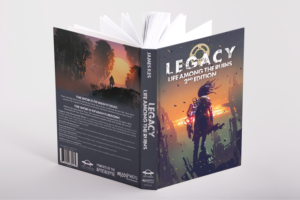
For a good example of what you want to see in a license, pick up one of Fat Goblin Games’ free stock art licenses. While not every license is the same as FGG’s, this one demonstrates the key pieces you want to see and adhere to:
- Grant of Rights
- Permitted Uses
- Restrictions on Use
- Credit
Knowing those components will ensure you stay within the intended, and legal, use of the stock art.
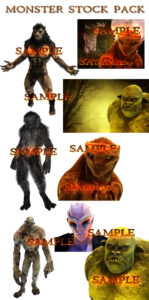
Why Choose Stock Art?
Artless RPGs are a rot ruining dice rolling roleplaying games run around your romper room’s round table. That is to say, your RPG will describe what it needs but all games benefit from images to fill in when words fail to convey the visuals. If you’re crafting an RPG, they improve when they contain artwork. If you want that level of professionalism, that leaves you two choices: Draw it or use someone else’s. For those that choose not to draw, stock art is a valid option because there’s a lot of excellent choices that will fit your budget and aesthetic. Add to that, stock art allows you to peruse and use a variety of images until you find an unexpected piece of inspiration. I cannot count the number of times stock art sparked an idea for me. For small press and new projects, stock art is a winner.
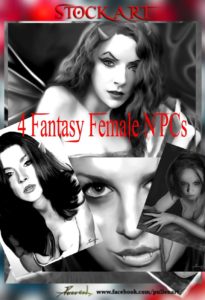
What Is Available?
A wide variety of stock images exist in a variety of styles and quality from sketches to comic-style to CGI to painted productions to photographs, if you look you’ll find what your project needs. Headshots, group shots, object shots, scenes, and action shots, all types are available.
For this article, I’m sharing my most recent purchase of over 90 stock images for under $3. I chose these pieces because the thumbnail previews spoke to me and the price could not be argued. As such, I ended up with a varied collection. In terms of art style, my selections included GCI artwork, digitally painted pieces, and digital ink and colored works. Most of the images are of people and monsters, but a few are objects and buildings. I’m awash in headshots of humans and some full body shots of monsters. I did not land any group shots that might represent the heroes of a normal fantasy RPG, but I’m set for NPCs and enemies. Mixed with the right adventure, one that’s heavy on individuals or interest, this collection will suffice. For the cover, I’d likely lean into either Rick Hershey’s Red Cap Goblin or one of Sandy Yoo’s images that I selected.
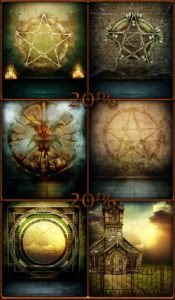
With 90+ images, I have some options but is it enough to publish a PDF adventure? While it will not rival a Larry Elmore painted cover and inked interiors, it will still elevate the product. It will not be pages of text without visual breaks nor will it look like you created art using a set of Crayolas. Naturally, it will not rival companies with art departments and the income to cover original artwork, but that’s the point of stock art. If you can afford Elmore, do it. If you can’t but you still want to jazz up your product, or augment the number of images, stock art is your friend and the cost is the definition of effective.
My sales pitch aside, I bought these pieces because they spoke to me and the value is evident. Having a robust stock art library lets me know that if I ever get to firing off projects, I’m prepared in terms of visuals. If you’re considering a simple project, or expanding an existing work, stock art is a worthwhile investment.
Stocks I Bought (And The Price I Paid)
-
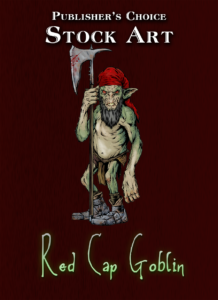
By Rick Hershey Publisher’s Choice – Quality Stock Art: Red Cap Goblin from Fat Goblin Games (Watermarked PDF for $0.50 $1.00)
- One image by Rick Hershey / “Publisher’s Choice Quality Stock Art © Rick Hershey / Fat Goblin Games”
- Spot Art 1 from Aegis Studios (Watermarked PDF for $0.20 $0.40)
- 21 images by Sandy Yoo / “© Sandy Yoo, 2020”
- Fantasy Stock Art 2: Female NPCs from Patrick E. Pullen (Watermarked PDF for $0.59 $1.17)
- Four images by Patrick E. Pullen / “All artwork is copyrighted by Patrick E. Pullen”
- Art Resource: NPC Portraits, Vol. 1 from Above Average Creations (Watermarked PDF for $0.70 $1.39)
- 47 images by Jerry Keyes / “© Jerry Keyes, 2011. Licensed by Above Average Creations. Used by permission.”
- 1 USD Stock: Pentagrams from Sade (Watermarked PDF for $0.50 $1.00)
- One image by, I’m assuming, Sade. The information is unclear.
- 1 USD Stock: Monsters from Sade (Watermarked PDF for $0.50 $1.00)
- Eight images by, again, I’m assuming, Sade. The information is unclear.

The “Take Stock! Stock Art Sale” at DriveThruRPG ends on Friday, May 1, 2020 at 10:00 am EST.
Egg Embry participates in the OneBookShelf Affiliate Program. This program provides advertising fees by linking to DriveThruRPG.
Latest posts by Egg Embry (see all)
- New Gamemaster Month 2023 - January 20, 2023
